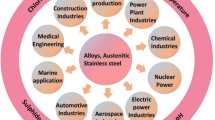Abstract
This work is concerned with the development of a technique to observe the onset of corrosion as it occurs beneath a temporary protective layer. Such temporary protectives include paints, varnishes, greases and oils that are applied to metal surfaces to give short-term protection from corrosion. The objective of this project was to develop a technique that could be used to evaluate the effectiveness of various temporary protectives in different environments, without the need to remove the protective layer, thus eliminating the possibility of any chemical changes or loss of corrosion products occurring as a result of removal. The temporary protective layers are typically 25Μm for paints and 15Μm per layer for varnishes. The 6.3 keV fluorescence X-ray is able to penetrate such layers, but the large escape depth (∼10Μm) of the X-rays means that for a thin protective layer a large proportion of the X-rays detected will originate from deep within the substrate and the resultant spectrum will be representative of the bulk rather than the surface. To enhance the surface sensitivity of the CXMS technique, the near surface region must be enriched in the isotope Fe-57. To achieve this, Fe-57 was vacuum evaporated onto the surface of mild steel substrates and subsequently diffused into the near surface region. An approximate 20 nm Fe-57 layer was deposited onto mild steel samples. The surface enriched samples were then annealed to allow the Fe-57 to diffuse into the near surface region of the mild steel substrate, and also to allow back diffusion of the substrate. A diffusion model was developed to predict the surface distribution of Fe-57 as a function of annealing parameters. The computer diffusion model allowed the ideal annealing conditions to be estimated to obtain a required near surface environment. It was essential that the annealing conditions did not result in any surface oxidation, and did result in a surface that was characteristic of mild steel. CEMS and CXMS spectra were recorded of samples before and after annealing, and also dynamic Secondary Ion Mass Spectrometry (SIMS) was used to monitor the enrichment and diffusion process. Energy Dispersive X-ray Analysis (EDXA) was also used to characterize the surface. A number of enriched samples were prepared and treated with a variety of surface temporary protectives. The CXMS spectra were recorded before and after exposure of the coated samples to various aggressive environments.
Similar content being viewed by others
References
G. Longworth, X-ray and conversion electron Mössbauer scattering for chemists, in:Mössbauer Spectroscopy Applied to Inorganic Chemistry, ed. G.J. Long, Vol. 1 (1984).
Smithells Metal Reference Book, 6th edition, ed. E.A. Brandes, Section 13, Diffusion in Metals, p. 1–14.
H. Oikawa, Lattice self diffusion in solid iron: A critical review, Technology Reports, Tohoku Univ. 47(1982)67.
E. Zinner, Depth profiling by secondary ion mass spectrometry, Scanning 3(1980)57.
BS 3900 British Standard Methods for Test for Paints, Part F4, Resistance to Continuous Salt Spray (1968).
S.C. Thorpe, Surface corrosion studies, PhD. Thesis, Sheffield City Polytechnic (1987).
Author information
Authors and Affiliations
Rights and permissions
About this article
Cite this article
Brooks, J.S., Thorpe, S. A method for the study of surface corrosion beneath protective layers. Hyperfine Interact 47, 159–178 (1989). https://doi.org/10.1007/BF02351606
Issue Date:
DOI: https://doi.org/10.1007/BF02351606




